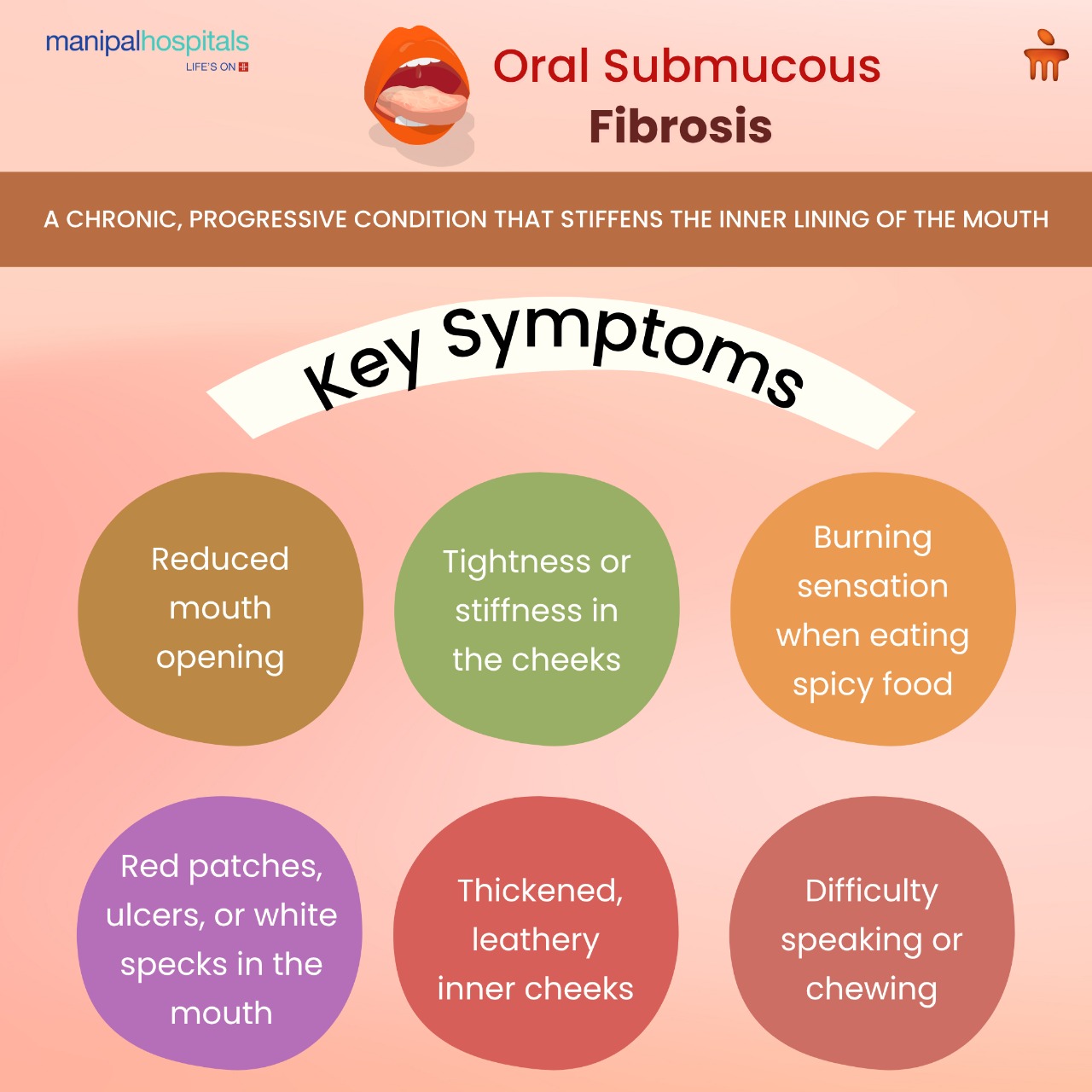
When we think of oral health issues, we often picture cavities or gum disease. But there's another lesser-known condition that's affecting millions, especially across South Asia, and it’s more serious than most people realise. We’re talking about Oral Submucous Fibrosis (OSMF), a chronic condition that slowly tightens and hardens the tissues inside the mouth. If left untreated, it can even lead to oral cancer. In this blog, let’s break down OSMF in simple terms: what it is, what causes it, who’s at risk, and most importantly, what you can do about it.
Synopsis
- What Is Oral Submucous Fibrosis (OSMF)?
- The Root Cause: Areca Nut Chewing
- Who’s at Risk?
- Early Warning Signs of OSMF
- How Is It Diagnosed?
- Is There a Cure?
- The Role of Nutritional Deficiencies
- How Oxidative Stress Makes It Worse
- Antioxidants to the Rescue
- Can Supplements Help?
- What the Treatment Might Involve
- Conclusion
What Is Oral Submucous Fibrosis (OSMF)?
Oral submucous fibrosis is a chronic condition that affects the soft lining inside your mouth. Once the condition sets in, over time, the tissues begin to lose their flexibility. They start to tighten and thicken and form fibrous bands that limit movement. You might find it harder to open your mouth, speak clearly, or even eat food without pain. It causes progressive hardening of the inner tissues of the mouth, eventually making it difficult to open the mouth fully.
Unlike cavities or gum infections, which present with pain or swelling, OSMF develops gradually and often goes unnoticed in the early stages. What’s concerning is that many individuals continue their daily routines unaware that a potentially precancerous condition is silently advancing within their mouths.
In some cases, this tightening doesn’t stop with the cheeks. It can extend towards the throat and even the upper part of the food pipe. Many people describe it as a feeling of stiffness, as though the mouth has shrunk. And once this hardening sets in, reversing it becomes difficult unless the habit causing it is addressed early.
The Root Cause: Areca Nut Chewing
The areca nut is often chewed alone or as part of betel quid in many parts of India, Pakistan, Bangladesh, and Sri Lanka, and is the leading cause of OSMF. What makes it particularly dangerous is how common and socially accepted it is, especially among the younger population these days.
Inside the areca nut is a chemical called arecoline. Once it enters the system, it triggers the body to produce more collagen in the mouth. Normally, collagen is broken down and replaced. But with constant chewing, it builds up instead.
This excess collagen begins to form fibrous bands that slowly reduce the flexibility of your inner mouth tissues. Over time, this damage becomes permanent unless the habit of areca nut chewing is stopped completely.
Who’s at Risk?
Oral submucous fibrosis doesn’t always affect who you might expect. While it’s often seen in adults with long-standing chewing habits, an increasing number of young people, especially teenagers, are being diagnosed today. This concerning shift is largely driven by the aggressive marketing of areca nut products in attractive, flavoured forms that appeal to school and college students.
In certain regions, women are more affected than men, possibly because the habit is culturally passed down or considered acceptable in family settings. Studies have shown that nearly 5% of women and around 2% of men are living with OSMF. Some individuals seem more prone to developing the condition even if their chewing habits aren’t as heavy.

Early Warning Signs of OSMF
Many people don’t realise anything is wrong until the condition has already progressed. But there are signs in the early stages that are easy to miss:
-
Burning sensation while eating spicy food: This is often one of the first things people notice. Especially when eating something that didn’t cause discomfort before.
-
Red patches or small ulcers in the mouth: These may appear and disappear, which is why many people ignore them.
-
Tightness or stiffness in the cheeks: You might feel as if your mouth isn’t moving as freely as before.
-
Reduced mouth opening: Gradually, it becomes difficult to open your mouth fully, especially when yawning or eating.
-
Changes in texture or colour inside the mouth: The inner cheeks may look pale, leathery, or slightly shiny.
-
White patches or specks (leukoplakia): These should never be ignored, as they can be early signs of something more serious.
How Is It Diagnosed?
Oral submucous fibrosis is usually diagnosed during a visit to the Oral Medicine Specialist. Identification can be done based on clinical examination and your history. Here’s what the doctor typically looks for during diagnosis:
-
Restricted mouth opening: Difficulty opening the mouth wide, particularly when trying to stretch the jaw.
-
Pale or blanched inner cheeks: The normal pink colour is often replaced by a whitish, shiny appearance.
-
Palpable fibrous bands: Thick, rope-like tissues can often be felt inside the cheeks.
-
Stiffness or reduced cheek elasticity: A firm, leathery texture when the area is gently pressed.
-
History of chewing habits: This is almost always a key part of confirming the diagnosis. This is nearly always a crucial factor in confirming the diagnosis of oral submucous fibrosis.
Is There a Cure?
There’s no one-shot cure for OSMF, but early action can make a big difference. Here’s what you should know:
-
There’s no full cure as such, but if you catch it early and stop chewing completely, things can get better.
-
Once the tissues become hard, it’s not easy to reverse. But yes, symptoms can be controlled.
-
We usually try to reduce the burning and improve how much the mouth opens. That’s the main goal.
-
If someone keeps chewing, no treatment will really work. That habit has to stop first, otherwise nothing helps.
-
The younger the patient and the earlier we catch it, the more chances we have to slow it down or even reverse it a little.
The Role of Nutritional Deficiencies
Many patients with oral submucous fibrosis have low levels of essential nutrients in their diet. This is especially common among individuals from lower socioeconomic backgrounds and those with poor dietary habits.
When the body lacks vitamins like A, C, E, or even iron, it doesn’t heal well. The tissues inside the mouth become more sensitive to the chewing of the areca nut, and the burning gets worse. These deficiencies don’t directly cause OSMF, but they definitely make the condition harder to manage. That’s why part of the treatment often includes restoring balance through nutritional food or supplements.
How Oxidative Stress Makes It Worse
Our body naturally produces microscopic particles called free radicals as part of normal activities in the cells. When there is too much buildup of free radicals in the body, they cause what is called oxidative stress. This chain can start damaging healthy cells in the body.
In people with OSMF, oxidative stress can make the mouth tissues even weaker and slow down healing. It also increases the risk of the condition progressing further or becoming cancerous. That’s why controlling oxidative stress is an important part of managing OSMF.
Antioxidants to the Rescue
To fight oxidative stress, the body needs antioxidants. These are substances that help neutralise free radicals and protect your cells from damage. In OSMF, antioxidants such as vitamins A, C, and E play a useful role.
The antioxidants don’t reverse the disease, but they can reduce inflammation and damage from continuing. They can also soothe the burning sensation and support the healing of the mouth tissues. Many doctors also recommend antioxidant supplements along with dietary changes to help slow down the progression and reduce the chances of cancerous changes.
Can Supplements Help?
Supplements are part of the treatment process along with stopping the chewing of areca nuts. Many patients with OSMF experience improvement when antioxidant supplements are added to their treatment. The supplements help reduce the burning and support tissue repair. They are also sometimes known to improve mouth opening over time. Supplements like vitamin A, C, E, iron, and certain minerals are commonly prescribed as part of the treatment.
What the Treatment Might Involve
OSMF also comes with a risk of cancer of 0.7% to 1.3% per year, with a 10-year risk around 8%. That’s why early action is critical. The sooner the treatment begins, the better the chances of slowing it down or preventing further complications.
-
Quit the chewing Habit. Completely: This is always step one. If the chewing doesn’t stop, nothing else really helps.
-
Steroid Creams or Injections: These are used to reduce inflammation and make the tissues a little more flexible.
-
Vitamin and Iron Supplements: Usually needed if there are deficiencies. They support healing and reduce burning.
-
Mouth Exercises or Physiotherapy: Helps with improving mouth opening. It takes time, but regular movement can be a slight improvement.
-
Surgery: Only considered in severe cases where the mouth can barely open and nothing else has worked.
Conclusion
Oral submucous fibrosis is not just a minor mouth issue. It’s a serious condition that can affect the way you eat, speak, and live your daily life. If it is ignored, it can even lead to oral cancer. The good news is that it can be prevented. The earlier you stop the habit and get checked, the better your chances of recovery.
Consult our oral medicine specialist in Bangalore for proper diagnosis and management.
FAQ's
The primary cause is chewing areca nut (often found in betel quid), due to a chemical called arecoline, which causes collagen to build up and stiffen the tissues inside the mouth.
Look for a burning sensation when eating spicy food, red patches or small ulcers, a feeling of tightness in the cheeks, and changes in the mouth's inner texture or color. You may also face difficulty opening your mouth fully.
There's no complete cure once fibrosis is advanced, but early action can help manage the condition. The first step is to immediately stop chewing areca nut, as no other treatment works if the habit continues.
Nutritional deficiencies (e.g., Vitamins A, C, and E, as well as iron) can exacerbate OSMF symptoms. Antioxidants help fight oxidative stress and are often part of treatment to support healing and reduce burning.
OSMF carries a major risk of developing into oral cancer. Reports indicate an incidence of 0.7% to 1.3% per year, and a 10-year risk of around 8%. This is why early diagnosis and stopping the causative habit are crucial.





















 10 Min Read
10 Min Read




.png)


.png)








